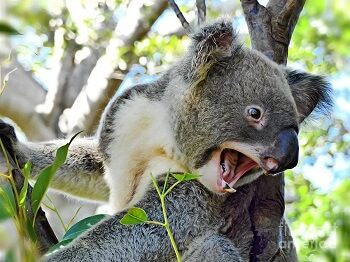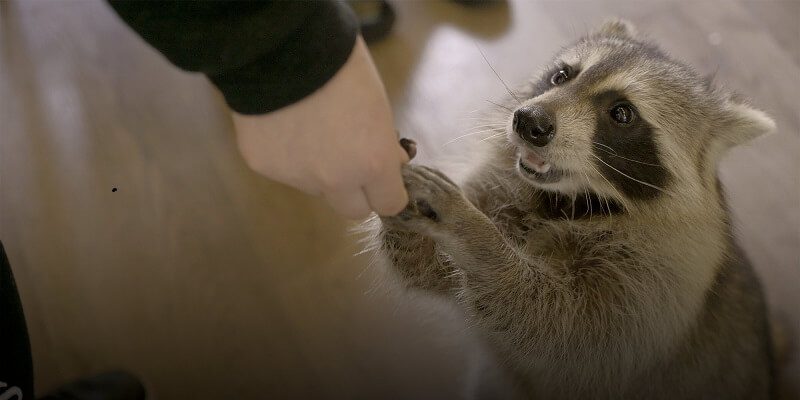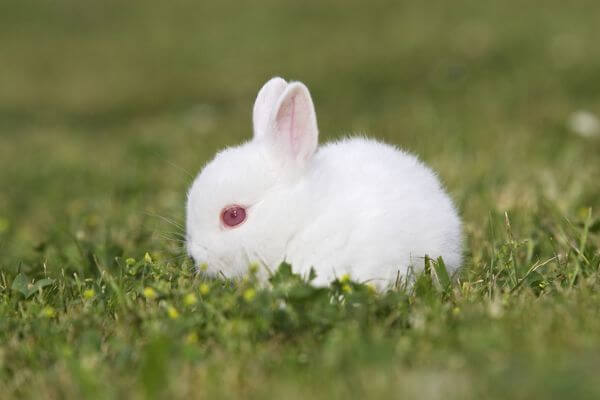Koala bear is the name under which the popular Australian herbivore marsupial mammal is known. However, the koala is not a bear; instead, it is a distinct species.
The koala bear is a marsupial that loves trees, with large round ears and an oval black nose. Koala is an iconic symbol of Australia, the only place in the world where they can be found. Like kangaroos, wombats, and opossums, koala also has pouches in which they keep their babies. Koala spends most of his time sleeping and eating.
What does a Koala look like?
Koala is 60 to 85 centimeters high when fully developed. Its weight varies, depending on where the koala lives. The northern Koala weighs around 4 to 8,5 kilograms and the southern koala weighs around 7 to 13 kg. Males typically weigh 50 percent more than females.
Are Koalas aggressive?
Although normally they are not dangerous, koalas attack occasionally when they are cornered or threatened. Their sharp teeth and claws can cause significant injury to humans or other animals.
Koala attacks on people have been documented, leading to injuries that required medical care. Koala wounds and scratches can require stitching, antibiotics, and an anti-tetanus vaccine.
Koala is most likely to attack when it feels surrounded. People who travel with dogs to their habitats are at greater risk of being attacked because Koalas see dogs as threats.
Also find out whether lions eat hyenas.
Female koala bears can also attack if a person accidentally gets lost or gets too close to her puppies. Experts suggest that people should remain cautious and keep a good distance between themselves and koala bears, especially koala mums.
Koala feeds mainly on eucalyptus, which is an energy-reduced food. As a result, koala bears spend most of their time sleeping and do their best to avoid unnecessary energy-intensive activities. These features make them quite safe because aggressive behavior consumes energy.
Koalas also weigh just 20 to 30 lb., which makes them too small to pose a serious threat to most adult people. However, koalas do not have sharp teeth, such as incisive teeth, but strong jaws can cause deep muscle injuries. They also have long and sharp claws that they use mainly for climbing, but they can also use them defensively. While koala bears are generally slow, they can move quite fast for short periods of time when they feel threatened.
A real case of an aggressive Koala
It seems hard to believe that an animal with such a mild look is, in fact, very aggressive.
But sometimes these quiet animals become violent. Aggression between koalas is usually less intense, but things change when it comes to other animals or people, which they bite and scratch with unsuspecting ferocity.
For example, in 2006 four men entered a zoo to steal a koala that they intended to sell later. But, when they opened the cage where the koala was, they discovered that the creature was impossible to steal. According to the Sydney Morning Herald, the animal scratched them so badly that they had to give up the plan.
The danger of Koala Chlamydia
A silent killer is spreading to Australia’s koala population, posing a threat that, according to wild-lived experts, could lead to the disappearance of the emblematic marsupial in large parts of the country, CNN wrote.
To blame is Chlamydia, a sexually transmitted disease that affects more than 100 million people every year around the world and can cause infertility in people if it is not treated.
For koalas, uncontrolled chlamydia can cause blindness and painful cysts in the reproductive tract of the animal, which can lead to infertility or even death.
Worse still, antibiotics used to treat the disease can destroy the delicate intestinal flora that the koala needs to consume their basic food, consisting in eucalypt leaves, which causes some of them to die of hunger even after they have been healed.
The disease can also spread rapidly.
There are two types of chlamydia in Australian koalas, one of which, Chlamydia Pecorum, which is almost entirely responsible for the worst cases of the disease in the population. A paper published in September 2020 in FEMS Microbiology Reviews said that the most dangerous strain of chlamydia could have come from domestic animals brought to Australia by European colonizers in the 19th century.
The disease spreads to koala populations through breeding and social behavior related to the mating, although joeys – koala cubs – can get the disease from their mothers. According to Sydney University, infection rates in some continental koala populations in Queensland, New South Wales, and Victoria can be up to 100%, making them completely infertile.
A chlamydia vaccine, developed by researcher Timms over the past decade, is being tested among the country’s koala population as a way to protect animals from serious infections.
Control tests are ongoing to test the effectiveness of the vaccine on small groups of koalas – usually around 20 or 30 at a time, Timms said. The current test is the largest ever, involving 400 koalas.
To conclude, this type of stain, Chlamydia Pecorum, cannot be transmitted to humans, but the second stain, Chlamydia Pneumoniae, can be transmitted if, for example, a koala were to urinate on somebody.
Curiosities about koalas
The Koala has one of the smallest brains in relation to body weight when compared to any other mammal. The small brain size of the koala may be an adaptation to the energy restrictions imposed by its food, which is insufficient to support a larger brain. Because of its small brain, the koala has a limited ability to behave in complex or unfamiliar ways. For example, when brought in front of a eucalypt leaf lying on the ground the animal cannot adapt to change its feeding routine and will not eat it.
 Births in the koala family are unique, that is, the female gives birth once. Births occur after 34 to 36 days of gestation. The cub is called joey and takes his head out of the marsupium for the first time at around the age of five months. Until the cub turns six months it is just breastfed, and after that it is fed by its mother with the predigested eucalypt, which comes directly from the mother’s feces. After this period, the joey is completely out of the marsupium and sticks to his mother’s back until it reaches almost a year in age.
Births in the koala family are unique, that is, the female gives birth once. Births occur after 34 to 36 days of gestation. The cub is called joey and takes his head out of the marsupium for the first time at around the age of five months. Until the cub turns six months it is just breastfed, and after that it is fed by its mother with the predigested eucalypt, which comes directly from the mother’s feces. After this period, the joey is completely out of the marsupium and sticks to his mother’s back until it reaches almost a year in age.
A koala can live up to 15 years in the wilderness, and a little more in captivity.
Killed in large numbers for their fur, especially between 1920 and 1930, the koala number fell from millions to several hundred thousand. In the south of their area, they practically disappeared, except for one population in Gippsland, Victoria. Some animals have been transferred to small islands, especially Phillip Island, where they have done so well that these koalas have been used to repopulate much of the original area of Victoria and the south of New South Wales.
Like people, koalas have fingerprints. They are the only mammals except for primates that have them.
Although koalas, in general, are silent, the male shouts a loud cry during the mating season, which can be heard from about a kilometer away. Koalas can make other sounds, from snores to screams.
-Eucalypts are poisonous for most animals. Koala’s digestive system creates a bacterium that disables the poison.
To wrap up
People and koalas have a long and varied history. Since the beginning of 1900, more than one million koalas have been killed for their fur. The koala population was in danger of being wiped out before the practice of hunting these creatures ceased.
The Koala can be very aggressive when disturbed or surprised by people in their natural habitats. They defend themselves with sharp teeth and sharp claws that are similar to nails. These defensive measures are capable of crushing the skin and can cause considerable damage.




